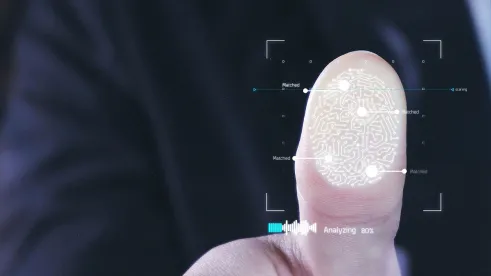Biometric class actions have proliferated in recent years — and with more states eyeing comprehensive data privacy legislation, companies that use biometric data should plan for the surge to grow.
With rare exceptions, these cases end either in settlement or via a successful dispositive motion. In this post, we will discuss some of the trends we have observed from reviewing 15 settlements of class actions brought under Illinois’s Biometric Information Privacy Act (BIPA), 740 Ill. Comp. Stat. Ann. 40 et seq. (Illinois is currently the only state that authorizes a private right of action for violation of biometric information privacy laws). Part II will examine some successful (and unsuccessful) dispositive motions filed by companies facing BIPA claims.
Highlights of BIPA Settlements:
-
Average recovery of $440 per class member
-
Class sizes vary widely from 724 members to 15.37 million members
-
Slightly over half of the settlements feature injunctive relief
-
Majority of settlements utilized a claims process
-
Almost no settlements allowed unclaimed funds to revert to the defendant
The Big Question: How Much Money Are Companies Paying?
Damages in BIPA class actions add up quickly because the statute authorizes a penalty for each violation in the amount of $1,000 (for negligent violations) or $5,000 (for intentional violations), as well as attorneys’ fees and costs (740 Ill. Comp. Stat. Ann. 14/20). The availability of large statutory damages, plus the headlines about Facebook’s payment of $650 million to settle users’ claims that its facial recognition technology violated BIPA, is enough to make any user of biometric data nervous (see In re Facebook Biometric Info. Privacy Litig., No. 3:15-cv-03747 (N.D. Cal.)). But even though the gross amount of Facebook’s $650 million settlement should inspire some caution, it only tells part of the story. The other critical piece of information is the class size because this number will give much better information about the value of each class member’s claim. The Facebook class included about 15.37 million class members. The parties estimated that each class member stood to recover a maximum of $342.
Thus, while headlines emphasize the total amount of the Facebook settlement, the per-class-member recovery in that settlement is lower than the average recovery of around $440 per class member. Though this is the average, we observed a fairly large range of potential recoveries, from just $21 per class member in Phillips v. BioLife Plasma, LLC, No. 2020 CH 05758 (Ill. Cir. Ct.) (though this was for one of two subclasses; the members of the other subclass each received an estimated $205) to $1,000 per class member in Wickens v. Thyssenkrupp Crankshaft Co., LLC, No. 1:19-cv-06100 (N.D. Ill.). A pattern emerges: on average, individual class members recovered more in smaller classes. For instance, in Wickens, there were only about 724 class members, far fewer than the roughly 15 million members in the Facebook class. One caution: Facebook may be an outlier in terms of size; the next largest class had roughly 1.11 million members (see Rosenbach v. Six Flags Entm’t Corp., No. 16 CH 13 (Ill. Cir. Ct.)).
Despite the variability in class sizes and recovery, attorneys’ fees constituted between 33% and 35% of the settlement fund in all cases but the Facebook class action (in which the court found that one-third of the $650 million fund was excessive and instead awarded $97.5 million). The fact that fee awards consistently amount to around one-third of the settlement fund suggests that attorneys’ fees may have been a driving factor in the cases with smaller class sizes but higher individual class member recoveries.
Finally, most of the settlements structured payment in similar ways. Twelve of the 15 settlements instituted a claims process for at least certain categories of class members, and 13 of the settlement funds were non-reversionary, which means all unclaimed settlement funds were either paid to a cy pres recipient or distributed to the class members who previously submitted claim forms. Further, all but one of these settlements required the defendant to pay the full amount of the settlement fund, rather than permitting the defendant to fund the settlement in phases and fund the next phase only if claims exceeded the amount of the prior phase. The Six Flags settlement did allow for a phased funding approach, but the settlement agreement noted that this approach was due to the severe economic hit Six Flags took during COVID-19. Thus, companies settling a BIPA class action should generally expect to pay the entire amount of the settlement fund, either to class members or to a cy pres recipient.
What Other Relief Is Included in the Settlements?
All of the settlements in our sample included monetary relief, but nine of the 15 settlements also contained prospective injunctive relief. The prospective relief in each settlement agreement looked similar, with defendants agreeing to (1) make improved disclosures regarding the collection and use of biometric data; (2) draft and provide written policies on the collection and retention procedures for biometric data; (3) obtain a written release to collect individuals’ biometric data; and (4) destroy biometric data in accordance with applicable law. The presence of prospective relief in a settlement agreement did not appear to have a significant impact on the monetary amount of the settlement — in other words, the presence of injunctive relief did not correlate with low recoveries per class member.
A future post will analyze some successful dispositive motions in BIPA cases to identify trends and emerging defenses.






 />i
/>i
